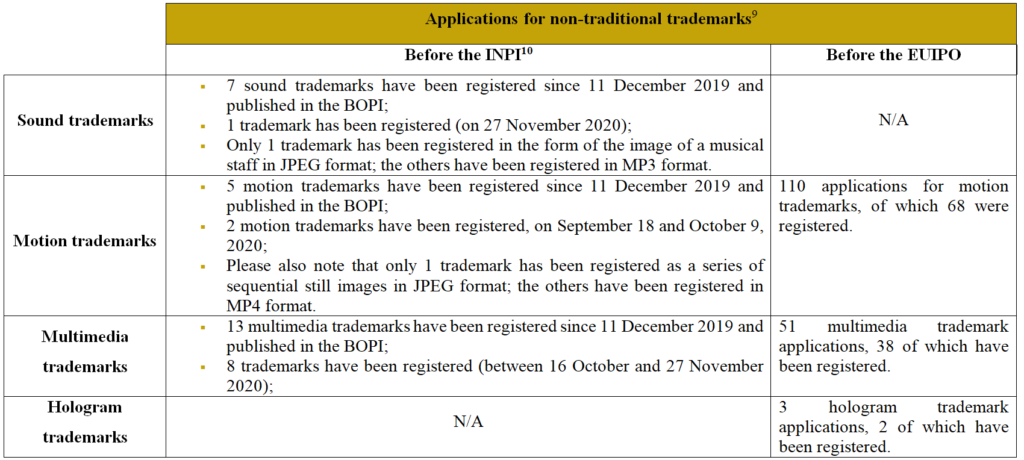Trademark Package: Assessing the filing of non-traditional trademarks
NON-TRADITIONAL TRADEMARKS
Assessing the filing of non-traditional trademarks since the first anniversary of the “trademark package” implementation
Despite trademark legislation in the EU no longer referring to the requirement of graphic representation, there hasn’t been an increase in filings of non-traditional trademarks. This article assesses the filing of non-traditional trademarks since the first anniversary of the “trademark package” implementation in the EU and explores why there hasn’t been a large uptick.
Non-traditional signs refer to a sound, a smell, a motion, a hologram, a colour, a taste that is registered as a trademark and enables the consumer to attribute an origin to a product.
At the end of the 1990s, in response to changes in marketing practices, trademark offices saw the registration of non-traditional trademarks[1].
While those signs constitute a valid trademark, both application and registration had actually remained on the edge.
Still, the introduction of the “trademark package” was to be accompanied by an increase in the number of applications/ registrations: what conclusions can be drawn after a year of implementation?
The introduction of the “trademark package” should have come with an increase in the number of such registrations, precisely, since it removes the requirement of graphic representation identified as a brake on the registration of such trademarks.
Among legislative texts within the “trademark package”, the 2015 Directive includes provision for trademarks being signs which are capable of distinguishing the goods or services undertaking from those of other undertakings and being represented in the register in a manner which enables the competent authorities and the public to determine the clear and precise subject-matter of the protection afforded to its proprietor[2]. The text no longer refers to the requirement of graphic representation.
However, as we will see in this article, the removal of such a requirement has, taking the French example, not been accompanied by a multiplication of non-traditional trademark filings.
In France, the 2015 Directive was transposed in the Ordinance of 13 November 2019[3], which came into force on the date of entry into force of Decree of 9 December 2019[4].
Previously, the IP Code while listing signs that could be registered as a trademark provided that they are “distinctive, lawful, available, and in the public domain”.
The new IP Code has simplified the trademark definition as “a sign used to distinguish the goods or services of one natural or legal person from those of other natural or legal persons.
Such a sign must be capable of being represented in the national trademark register in such a way as to enable any person to determine precisely and clearly the subject matter of the protection conferred on its owner”[5].
Moreover, the new provisions of the IP Code allow signs that are neither verbal nor figurative, such as sound, multimedia or motion trademarks, to be registered as trademarks as soon as the sign is “clear, precise, distinct, easily accessible, intelligible, durable and objective”[6].
Following this coming into effect, the French national trademark office has analysed, depending on the type of trademark, the number of applications and registrations of non-traditional trademarks and has tried to identify a trend in the registration of non-traditional trademarks[7]. Hereinafter, we proposed organising this analysis in the form of a board.
As it is, these figures do not yet make it possible to identify a trend in the registration of non-traditional trademarks. Still, one may note although half of the atypical trademarks filed within the last year before the INPI[8] have successfully been registered, the success of such trademarks is still relative. This is because uncertainties remain regarding this new legislation, particularly with regard to the assessment of the distinctive character of such trademarks or comparison method with identical or similar trademarks. These uncertainties are reinforced by the fact that there is not yet any case law interpreting the new IP Code provisions.
New issues will arise, for example the application of comparison methods to assess similarities with a non-traditional brand, our adaptation to the fight against online infringement.
Finally, on the subject of non-traditional trademarks, things could really change with the publication, in April 2021, of an EUIPO communication entitled New types of trademarks – Examination of formal requirements and grounds for refusal and invalidity, which should provide clarification to applicants on the criteria for accepting new types of trademarks, reinforce the legal predictability of these titles and ultimately initiate a change in practice towards more filings.
Before then, the Incopro Legal Network with our law firm UGGC will be able to advise right owners in the best possible way to protect their rights and to assist them in filing non-traditional trademarks before the offices.
[1] OHMI, 11/02/1999: smell of freshly cut grass registered as a trademark for a tennis ball.
[2] Article 3 of the Directive (UE) 2015/2436
[3] See: https://www.legifrance.gouv.fr/loda/id/JORFTEXT000039373287/
[4] See: https://www.legifrance.gouv.fr/loda/id/JORFTEXT000039467798/
[5] Article L. 711-1 of the IP Code
[6] Article R. 711-1 of the IP Code
[7] For instance, the most commonly used classes of goods and services are 9, 35, 38 and 41. Also, it has been observed that the applicants, natural or legal persons, are often linked to the field of telecommunications or audio-visual production.
[8] French national trademark office
[9] From S. Kolagji et M.Bigoy « Les nouveaux types de marques un an après l’entrée en vigueur du Paquet Marques : bilan chiffré, exemples et analyse », PIBD 1151-IV-1, January2021
